Thursday Apr 03, 2025
Thursday Apr 03, 2025
Wednesday, 23 December 2020 00:00 - - {{hitsCtrl.values.hits}}
Treasury Secretary S.R. Attygalle in an exclusive interview with the Daily FT shares key insights into Budget 2021, its broader objectives and benefits and growth drivers as well as the thorny issue of debt challenge and downgrade of sovereign ratings by all leading agencies. In what could be described as a comprehensive assessment of the challenges and opportunities post 2021 Budget, Attygalle also recaps the background leading to the preparation of the Government’s key fiscal roadmap and factors considered and policy tools used to achieve key objectives of stabilising the COVID-19 hit economy and stimulate an early and broad-based recovery in the real economy. According to Attygalle, the private sector and other stakeholder response to Budget 2021 has been positive and the Government is fully committed to ensure speedy implementation of the remainder of 2021 Budget proposals. Here are excerpts:
By Nisthar Cassim
|
Treasury Secretary S.R. Attygalle
|
Q: What was the emphasis of the 2021 Budget?
It is comprehensively “growth” oriented.
Q: What were the factors that resulted in the 2021 Budget?
The country has been experiencing slow and low growth since 2015, which by 2019 was only 2.3% vis-à-vis 5% in 2014. Contractors and suppliers who had supplied a good or a service to the Government had not been paid their dues, which by the end of 2019 was almost Rs. 250 billion. NPL in the banks had increased to almost 5% from the lows of 1-2 % with almost 25% of those in the NPL constituted by SMEs. The electricity sector that requires at least 200 MW to be added annually did not see a single MW added to the electricity generation capacity.
On the external side, the country was not able to leverage on the low oil prices. I mean oil prices which averaged around $ 101/bbl during the 2010-2014 era, almost halved during the 2015-2019 period to an average of around $ 56.8/bbl, where at times it was as low as $29/bbl. Had we leveraged it properly, we would have been able to clean the balance sheets of CEB and CPC while also creating a price stabilisation fund to mitigate the impact of oil price volatilities, creating a more stable retail fuel price regime in the country which would have created a more stable environment for businesses.
Instead, by slashing the fuel prices with no thought to the consequential impact of such action, the end result was that we saw an influx of imported vehicles – so much so that the country now has a stock of vehicles sufficient for two years.
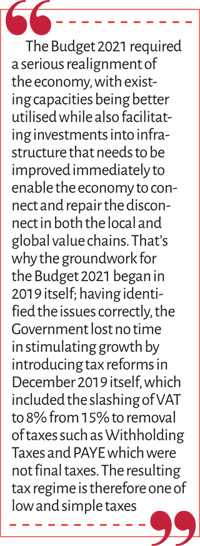 |
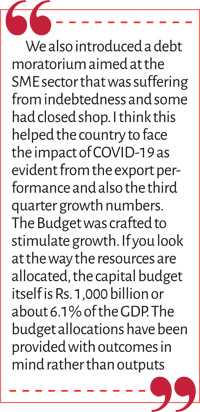 |
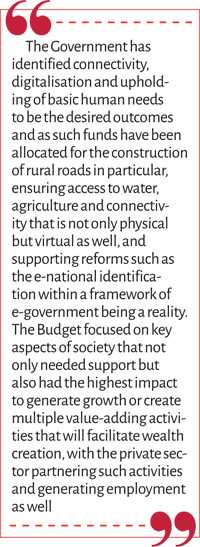 |
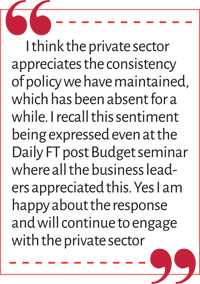 |
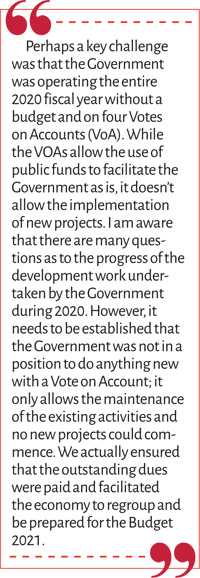 |
 |
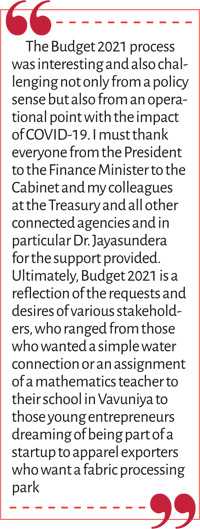 |
 |
 |
 |
While the cost of oil imports reduced, such savings were however used for the import of vehicles which only served to clog the streets and pollute the environment. To me the worst aspect is that instead of using the import savings to meet the foreign currency debt repayment, the unrestrained imports resulted in the country borrowing a further $ 11,950 million during the period 2015-2019 by way of International Sovereign Bonds, of which actually $ 6,800 million had been raised during the period 2018 and 2019. This has created a multitude of issues. It would appear that we lost a wonderful opportunity to actually create better value in the economy, with a diversified export base that is able to compete in the global marketplace. Instead we had imported vehicles and accumulated debt.
Therefore, the Budget 2021 required a serious realignment of the economy, with existing capacities being better utilised while also facilitating investments into infrastructure that needs to be improved immediately to enable the economy to connect and repair the disconnect in both the local and global value chains.
That’s why the groundwork for the Budget 2021 began in 2019 itself; having identified the issues correctly, the Government lost no time in stimulating growth by introducing tax reforms in December 2019 itself, which included the slashing of VAT to 8% from 15% to removal of taxes such as Withholding Taxes and PAYE which were not final taxes. The resulting tax regime is therefore one of low and simple taxes.
We also introduced a debt moratorium aimed at the SME sector that was suffering from indebtedness and some had closed shop. I think this helped the country to face the impact of COVID-19 as evident from the export performance and also the third quarter growth numbers.
The Budget was crafted to stimulate growth. If you look at the way the resources are allocated, the capital budget itself is Rs. 1,000 billion or about 6.1% of the GDP. The budget allocations have been provided with outcomes in mind rather than outputs. The Government has identified connectivity, digitalisation and upholding of basic human needs to be the desired outcomes and as such funds have been allocated for the construction of rural roads in particular, ensuring access to water, agriculture and connectivity that is not only physical but virtual as well, and supporting reforms such as the e-national identification within a framework of e-government being a reality.
The Budget focused on key aspects of society that not only needed support but also had the highest impact to generate growth or create multiple value-adding activities that will facilitate wealth creation, with the private sector partnering such activities and generating employment as well.
Q: What challenges did the Govt. face or have to consider when preparing the Budget?
Well again it’s the legacy of low growth and it was made worse by the COVID-19 pandemic, which introduced a fresh set of variables to grapple with, including lockdowns, quarantines, social distancing and even working from home. So whatever policy actions we had planned pre COVID-19 had to be adjusted to accommodate and address the issues that arose due to COVID-19.
The Budget had to be prepared to stimulate the economy while also supporting the vulnerable.
Perhaps a key challenge for the Government was that the Government was operating the entire 2020 fiscal year without a budget and on four Votes on Accounts (VoA). While the VOAs allow the use of public funds to facilitate the Government as is, it doesn’t allow the implementation of new projects. I am aware that there are many questions as to the progress of the development work undertaken by the Government during 2020. However, it needs to be established that the Government was not in a position to do anything new with a Vote on Account; it only allows the maintenance of the existing activities and no new projects could commence.
We actually ensured that the outstanding dues were paid and facilitated the economy to regroup and be prepared for the Budget 2021.
Q: You have said this Budget is growth and development oriented. Can you cite a few proposals?
Yes. As I said before, almost a third of the capital investment or around Rs. 350 billion has been allocated to the construction of roads and in that also the flagship project of the Government, the 100,000Km project, is focused on the construction and rehabilitation of rural roads.
We have to bear in mind that Colombo is not a microcosm of the entire country and that at least 60% of our population lives in rural Sri Lanka. This is why the connectivity of rural Sri Lanka to urban Sri Lanka has been given prominence and in fact this is why we have stopped or rather shelved projects such as the LRT. It is also part of the agriculture supporting strategy and will provide farmers access to market places. It’s important when viewing the proposals that a holistic view be taken.
The second item is the focus on water, both drinking and for agriculture. Again, this will support rural Sri Lanka to not only engage in agriculture but also in ensuring that every citizen has access to clean water, a basic human right.
Q: In your view, what is the proposal or policy which will be the game-changer?
Focus on technology. Because at the end of the day, technology will decide the state of the economy and thereby the quality of living we provide to our people. Let me take an example – we have enough sunlight and if we use technology, we can convert it to electricity. Similarly, we are endowed with otherresources including minerals, a fertile soil, and an ocean bed that is resource rich and if used in a responsible manner with the right technologies could yield unimaginable benefits.
So we have allocated a significant amount of funds in every sector of the economy to support technology infusion. These include the technology parks on ‘plug and play’ mode to attract investments, supporting infusion of technology in agriculture which could be in the form of supporting gene technology, use of drones to facilitate precision technology in agriculture and also in aquaculture, upping the capacities of the quality assurance agencies such as the ITI and the SLSI, harnessing solar power to generate electricity to meet our energy needs, supporting our schools with e-learning capacities or facilitating 4G technology – all are envisaged and resourced under the Budget 2021.
Secondly, the proposed digitalisation of Government processes which includes the e-NIC, e-procurement or even the e-monitoring for the RMV. My interest in these initiatives is because they not only make service delivery more efficient and will improve the business environment, but will have a positive impact on fiscal operations in supporting better revenue administration and expenditure management at all levels of Government. I am envisaging further improvements to RAMIS to support revenue collections and the National Single Window to support exporters has already begun.
These are game-changing investments that have the ability to have a short-term as well as a long-term impact.
Q: There is an opinion that this Budget is not practical and there will be no takers for some of the new incentives. Your thoughts?
At the outset itself my answer to that on 10 December when the Budget was passed in Parliament, we implemented eight Budget proposals. These included the support for working capital provided to SMEs affected by COVID-19; the loan schemes offered to install solar power panels on rooftops at an interest rate of 4%, where public servants could get a loan facility of Rs. 750,000 paid over 10 years; and also the loan scheme to support young entrepreneurs to invest in a startup based where they could get loan up to a maximum of Rs. 500,000 at 4% based on the business proposal without any other collateral. We have already planned the rollout of the roads and the water projects.
I understand that the Treasury has received many queries on these loan schemes, and I think that does indicate that there are takers; after all, I doubt if people are not keen to access funding at 4%. The Treasury as well as the other relevant agencies are working on the Budget proposals and before the end of this year you will see the announcement of a few more proposals.
So if this was not a practical budget, then how could we announce the implementation guidelines so soon? I am truly baffled.
Q: How are you managing the debt stock? What is our path?
Debt to GDP at the end of 2019 was around 86.8% of GDP with foreign currency debt accounting for almost 50% of the total debt.
Mind you, there’s a pipeline of around $ 9 billion of foreign currency projects that are in the yet to be disbursed in the next five to seven, which means should the status quo remain, even without signing new foreign loan agreements, on gross basis almost $ 2 billion will be added into the debt stock every year.
We examined the projects for which these loans have been earmarked and found that they included projects such as the LRT at a cost of around $ 1,600 million which also requires counterpart funding from the Government around $ 500 million for land acquisition and on the other hand we found irrigation projects at accost of around $ 250 million which have been earmarked to be executed with foreign loans and foreign contractors, when the expertise or the capacities were available in the country and the import content of such activities was also low.
So a choice had to be made, between rural roads and LRTs. Local expertise/capacities vs foreign expertise. In a nutshell, it appeared that the $ 9 billion loan pipeline had projects that are costly and those that could be easily undertaken with local funds and local contractors and expertise. That’s when we decided to cancel projects from the LRT to the irrigation projects I noted.
The Minister of Finance apprised the Cabinet of Ministers of this situation, proposing a way forward to ensure debt sustainability somewhere during May 2020 and the Cabinet of Ministers has approved this Foreign Resource Mobilisation Strategy for the period 2020-2025. It is in accordance with this strategy that we have cancelled some foreign-financed projects and realigned some to high impact sectors.
Going forward we will be financing most of the public investment through domestic currency. In fact public investment is channelled towards activities that can be undertaken by local contractors and experts with minimal imports. Foreign currency financing will be scrutinised closely. However, I must say that of the total foreign currency debt, apart from the $ 13 billion of ISBs, the balance debt is all at concessionary rates tenures in excess of 10 years. We expect this strategy to result in the foreign currency debt to stabilise at less than 40% of the total debt stock by the end 2025. At the same time we are confident our policy of investments rather than debt will support the debt to GDP compress to around 70% by end 2025.
Q: What is the strategy to finance Budget 2021?
As I said before, it will be predominantly financed by domestic currency. We also expect foreign concessional sources both multilateral and bilateral to finance around $ 1,800 million; we expect to also draw down the second tranche of the Foreign Currency Term financing facility of $ 700 million; we also expect to raise $ 800-1,000 million from domestic sources. If required we will also look into rolling over around $ 1,000 million if the market conditions are conducive.
Q: What reforms are you expecting in the State-Owned Enterprise (SOE) sector?
The Government has been very clear in its strategy pertaining to SOEs and as the Finance Minister Mahinda Rajapaksa clearly stated, the Government will introduce a regulatory framework providing the required commercial freedoms to the public enterprises in various sectors. The need is clear, the current system envisages providing autonomy with the necessary supports but with a high level of accountability given its nexus to public funds.
I think the Government action to call for RFPs from interested personnel to serve on the boards of SOEs to make them more professional and versatile was a true reform and already I can see some SOEs becoming much better. I am hopeful that many other SOEs will turn their operation around in the next year.
The Government is keen to streamline the SOEs as has been announced in Budget 2021, through amalgamation or consolidation of SOEs with similar objectives or at various points of the value chain, unlocking the advantages of scale, reducing duplication and easing the barriers to doing business including eliminating the unnecessary transfer pricing costs and to improve the business valuation.
In the last 12 months, we have issued directives by way of circulars providing greater operational independence and they include the recruitment of employees to fill in the already-approved cadre positions, and before the end of this year we will also be issuing a Guideline on governance of SOEs.
I have found the behaviour of the management and the boards of SOEs being less than desirable and I know that there is a nexus between such behaviours and the losses incurred. However, I also want to make a point that often eludes those who decry SOEs’ less than optimal performance. That is, most SOEs are oftentimes not capitalised adequately at the right time.
Take the case of SriLankan Airlines. While airlines by and large have been experiencing less than expected financial outcome, for a medium sized airline such as the SLA, the equity contribution has been inconsistent and has not been timely. I note that in the last 30 years, capital infusion has occurred only in 1993, during the period 2012-2014, where the Government decided to infuse $ 500 million, out of which only $ 375 million was infused. Making SLA operate on borrowed funds doesn’t help the final bottom line. That is why the Budget 2020 allowed a further capital infusion of $ 500 million over three years, of which $ 150 million has already been released.
I must state that in the existing portfolio of investments we also find SOEs that have run its course and also we find areas that the Government must pioneer investments.
It is in this background, having identified opportunities in the market, that the Government decided to incorporate four companies solely owned by ST, with private sector presence on the boards of management. These companies are Selendiva Investments, Sahasya Investments, Centre for Robotics (CERA) and Sri Lanka Biotechnology Institute (SLIBTEC).
Selendiva Investments will manage and consolidate the Government’s high end real estate assets, especially hotels, through the management and restructure of assets including the Grand Hyatt, Grand Oriental and Hotel Developers and prime land belonging to Ceynor Foundation adjacent to the Lotus Tower. More assets are expected to be vested with Selendiva. It is also expected that a few entities will be listed in the market hopefully before the end of the first half of 2021.
Selendiva’s role will be that of an investment firm, it will manage assigned investments of the Government that includes restructuring balance sheets, and if required broad basing the ownership structure and facilitating investors both foreign and local to invest in the country by providing end-to-end solutions. Selendiva is expected to be the key investment arm of the Government.
Sahasya Investments is a company that will own and manage the expressways and other such assets including land that can be easily accessed through the expressways. This company will raise funds and manage the expressways, both existing and those yet to come.
We strongly believe that we will be able to unlock significant investment value through these two companies in creating a better environment to attract investors both foreign and local.
SLIBTEC and the CERA both are ventures of this Government to open up our economy to new opportunities. Both SLIBTEC and CERA will work closely with predominantly the private sector. CERA’s collaboration with the private sector is expected to provide the required solutions mostly to improve productivity.
All these four companies have been empowered by the Cabinet itself and have been allowed full autonomy of operations, including in their decisions to hire employees, set their salaries and other aspects. The boards of these entities have a strong private sector presence and are active in their participation.
When we speak of reforms in the SOEs there are the traditional solutions of privatisation, corporatisation, etc. The impact of these solutions depends not only on the solution itself; it depends on a number of variables including in particular political support, the state of the economy, and stakeholder engagement.
The Government policy on SOEs is focused on introducing reforms to improve returns on investment. It is pragmatic in light of the many market disruptions and the change in global economic orders because COVID-19 has shown that government is ultimately the last resort in times of great distress to markets and SOEs play a key role in this context. This is true in developing countries and also in developed countries. Each country uses the institutional framework it has and in Sri Lanka’s case the existence of entities such as Sathosa and SPC helped in fighting the disease.
The cornerstone of Government strategy is autonomy; greater accountability will result in better and more productive outcomes.
Q: It is over a month since Budget 2021 was presented. What has been the response and are you happy?
I have participated in several seminars. I am told that in some seminars more than 2,000 participated. The response has been good. I think the private sector appreciates the consistency of policy we have maintained, which has been absent for a while. I recall this sentiment being expressed even at the Daily FT post Budget seminar where all the business leaders appreciated this. Yes I am happy about the response and will continue to engage with the private sector.
Q: Are you happy with the private sector response to Budget 2021 in terms of committing investments to new sectors which have got incentives?
Yes. The apparel industry has already commenced its investments at the Eravur Fabric Park, which is supported by the Budget 2021. Some Budget proposals will take a while to be implemented. It’s like the chicken and egg story, i.e. do people invest because there are incentives or does the Government provide incentives to those who have already invested? Budgets are an amalgamation of both. Sometimes we provide incentives like the Eravur Park because they wanted to invest and sometimes the incentive is an indication of the policy direction of the Government.
But I think since the Government has already indicated its policy direction and since the Government is committed to maintaining consistency, the private sector need not fear that the incentives provided will be taken away in a few months. The Government will follow through with its decisions. That assurance I can provide.
Q: Following responses what proposals will be tweaked or altered and why?
What is articulated in the Budget in many instances is the desired outcome. The implementation process will involve several actions and processes. Ultimately the essence of the proposals will remain unchanged.
Q: Implementation is always a challenge. What role is the Treasury expecting from other Ministries, Government agencies and public sector employees?
As I have already said we were preparing for the implementation aspect while the Budget was being prepared. That should indicate the commitment on the part of the Government to translate the Budget to action. That is the direction given by both the President and the Prime Minister.
In this regard, I thought it’s important to put my house in order first. We revamped the Treasury website and the first phase was done on the day of the Budget to facilitate, and this is expected to be completed by end January 2021. All through the budgeting process I was conscious of the changes required at the Treasury. I think since the last reforms undertaken by Dr. Jayasundera in 2012 no serious reform had taken place since then. I think, being at the Treasury for more than 15 years, that a serious introspection is required at least every three to five years. I thought it’s time the Treasury was restructured.
A Budget Implementation Unit will be established to coordinate the execution of Budget 2021. I have already identified the officers to be assigned and they have already started work. Departments have been structured to also meet the new demands. The Procurement Division will undertake not only the facilitation role it has been doing but also undertake analytical review on the key procurements in the country. I have requested them to relook at the procurement guidelines and ensure that the guideline is updated to meet the current requirements. E-Procurement will be rolled out at the earliest. The Treasury has always had a good talent pool and so when assigning officers to departments and even in some instances assigning them work, a skills matching as much as possible was done. Young officers have been promoted.
I expect the other agencies to also do their bit. I am confident that they will do so. We will coordinate with them to ensure the successful implementation of the Budget.
Q: How does the Government view the recent rating action and the engagement of the Government with the rating agencies?
The new Government has just announced a budget; rating action at this juncture without taking into account the policy actions to attain debt sustainability or fiscal consolidation as the Treasury has announced already is unacceptable and unwarranted. It appears that it was also pre-decided as well.
The Treasury and the CBSL actively engage with the rating agencies. In fact when Moody’s did its Rating review recently it was the State Minister for Money and Capital Markets and Public Enterprises Reforms who led the Government team although I was not present together with Treasury and CBSL officials; the Fitch rating discussion, the Secretary to the President and I decided to collaborate, with officers from the Treasury and the CBSL also participating; while the S&P call was taken by a team led by myself at the Treasury and the CBSL team was led by a Deputy Governor. At all the discussions with the rating agencies I think it’s fair to say that the officials clearly articulated the policy framework, but it would appear that the rating agencies had already decided to revise the country rating downwards prior to the discussions with the authorities.
Q: What was the budgeting process like and how inclusive was it?
The Budget 2021 is a result of the continuous engagement the Government had with stakeholders from all walks of life, may it be the public sector or private sector from top CEOs to the farmers and fishermen in the country. The President himself met these stakeholders at various fora, as did the Finance Minister. I must say I don’t advocate working in silos and I was happy to see the level of coordination within Government itself, specially between the Presidential Secretariat and the Treasury, which was made easy given that the Secretary to the President Dr. P.B. Jayasundera was a former distinguished Secretary to the Treasury; the experience and the knowledge he brings into economic policy making is outstanding and I can’t think of anyone else I would rather work with.
The Budget 2021 process was interesting and also challenging not only from a policy sense but also from an operational point with the impact of COVID-19. I must thank everyone from the President to the Finance Minister to the Cabinet and my colleagues at the Treasury and all other connected agencies and in particular Dr. Jayasundera for the support provided.
Ultimately, Budget 2021 is a reflection of the requests and desires of various stakeholders, who ranged from those who wanted a simple water connection or an assignment of a mathematics teacher to their school in Vavuniya to those young entrepreneurs dreaming of being part of a startup to apparel exporters who want a fabric processing park.
Having identified opportunities in the market, the Government decided to incorporate four companies solely owned by ST, with private sector presence on the boards of management. These companies are Selendiva Investments, Sahasya Investments, Centre for Robotics (CERA) and Sri Lanka Biotechnology Institute (SLIBTEC).
Selendiva Investments will manage and consolidate the Government’s high-end real estate assets, especially hotels, through the management and restructuring of assets including the Grand Hyatt, Grand Oriental and Hotel Developers and prime land belonging to Ceynor Foundation adjacent to the Lotus Tower. More assets are expected to be vested with Selendiva. It is also expected that a few entities will be listed in the market hopefully before the end of the first half of 2021.
Selendiva’s role will be that of an investment firm; it will manage assigned investments of the Government, including restructuring balance sheets and, if required, broad-basing the ownership structure and facilitating investors both foreign and local to invest in the country by providing end-to-end solutions. Selendiva is expected to be the key investment arm of the Government.
Sahasya Investments is a company that will own and manage the expressways and other such assets including land that can be easily accessed through the expressways. This company will raise funds and manage the expressways, both existing and those yet to come.
We strongly believe that we will be able to unlock significant investment value through these two companies in creating a better environment to attract investors both foreign and local.
SLIBTEC and the CERA both are ventures of this Government to open up our economy to new opportunities. Both SLIBTEC and CERA will work closely with predominantly the private sector. CERA’s collaboration with the private sector is expected to provide the required solutions mostly to improve productivity.

Discover Kapruka, the leading online shopping platform in Sri Lanka, where you can conveniently send Gifts and Flowers to your loved ones for any event including Valentine ’s Day. Explore a wide range of popular Shopping Categories on Kapruka, including Toys, Groceries, Electronics, Birthday Cakes, Fruits, Chocolates, Flower Bouquets, Clothing, Watches, Lingerie, Gift Sets and Jewellery. Also if you’re interested in selling with Kapruka, Partner Central by Kapruka is the best solution to start with. Moreover, through Kapruka Global Shop, you can also enjoy the convenience of purchasing products from renowned platforms like Amazon and eBay and have them delivered to Sri Lanka.
Discover Kapruka, the leading online shopping platform in Sri Lanka, where you can conveniently send Gifts and Flowers to your loved ones for any event including Valentine ’s Day. Explore a wide range of popular Shopping Categories on Kapruka, including Toys, Groceries, Electronics, Birthday Cakes, Fruits, Chocolates, Flower Bouquets, Clothing, Watches, Lingerie, Gift Sets and Jewellery. Also if you’re interested in selling with Kapruka, Partner Central by Kapruka is the best solution to start with. Moreover, through Kapruka Global Shop, you can also enjoy the convenience of purchasing products from renowned platforms like Amazon and eBay and have them delivered to Sri Lanka.